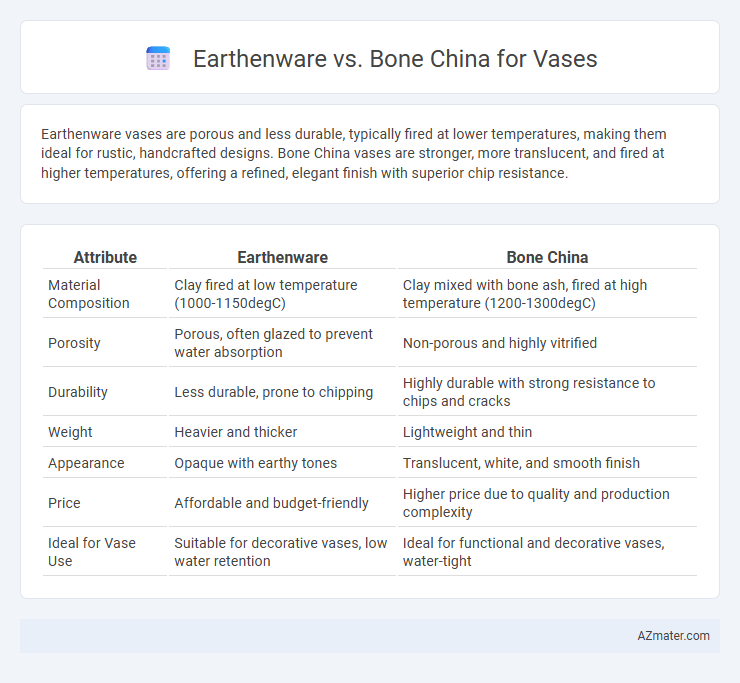Earthenware vases are porous and less durable, typically fired at lower temperatures, making them ideal for rustic, handcrafted designs. Bone China vases are stronger, more translucent, and fired at higher temperatures, offering a refined, elegant finish with superior chip resistance.
Table of Comparison
| Attribute | Earthenware | Bone China |
|---|---|---|
| Material Composition | Clay fired at low temperature (1000-1150degC) | Clay mixed with bone ash, fired at high temperature (1200-1300degC) |
| Porosity | Porous, often glazed to prevent water absorption | Non-porous and highly vitrified |
| Durability | Less durable, prone to chipping | Highly durable with strong resistance to chips and cracks |
| Weight | Heavier and thicker | Lightweight and thin |
| Appearance | Opaque with earthy tones | Translucent, white, and smooth finish |
| Price | Affordable and budget-friendly | Higher price due to quality and production complexity |
| Ideal for Vase Use | Suitable for decorative vases, low water retention | Ideal for functional and decorative vases, water-tight |
Introduction to Earthenware and Bone China Vases
Earthenware vases are crafted from porous clay fired at relatively low temperatures, resulting in a rustic, sturdy texture with a matte or glazed finish that highlights natural earth tones. Bone china vases are made using a refined mixture of bone ash, feldspar, and kaolin, fired at higher temperatures to achieve a translucent, delicate appearance combined with exceptional strength and chip resistance. Both materials offer unique aesthetics and durability, with earthenware emphasizing organic charm and bone china showcasing refined elegance.
Material Composition: Earthenware vs Bone China
Earthenware is made from natural clay with a porous texture, fired at lower temperatures around 1000-1150degC, resulting in a heavier and more porous material ideal for rustic vases. Bone china incorporates bone ash, kaolin, and feldspar, fired at higher temperatures near 1200-1300degC, producing a translucent, lightweight, and durable vase with a smooth finish. The presence of bone ash in bone china enhances strength and translucency, distinguishing it from the more porous, less refined composition of earthenware.
Manufacturing Process Differences
Earthenware vases are made from porous clay fired at lower temperatures around 1,000-1,150degC, resulting in a more porous and less durable finish that often requires glazing. Bone china vases incorporate bone ash with refined clay, fired at higher temperatures near 1,200-1,300degC, producing a stronger, translucent, and more refined ceramic with a smooth surface. The manufacturing process of bone china involves additional steps like deflocculation and precise temperature control, yielding a lighter, more resilient vase compared to the more rustic nature of earthenware.
Durability and Strength Comparison
Earthenware vases are more porous and less durable, prone to chipping and cracking under impact, making them less suitable for heavy use. Bone china vases offer superior strength and durability due to their high density and added bone ash content, providing better resistance to breakage and longer lifespan. The vitrified nature of bone china ensures a tougher, more chip-resistant surface compared to the more fragile earthenware.
Aesthetic Appeal: Texture and Finish
Earthenware vases feature a rustic, porous texture with a matte or satin finish that highlights artisanal craftsmanship and natural imperfections, creating a warm, earthy aesthetic. Bone china vases offer a smooth, glossy finish with delicate translucency and a refined surface that exudes elegance and sophistication. The contrast between the tactile, robust feel of earthenware and the polished, delicate appearance of bone china defines their distinct aesthetic appeals.
Weight and Handling Experience
Earthenware vases are generally heavier and thicker, providing a sturdy but less refined handling experience compared to bone china, which is lightweight and thin, offering a more delicate and elegant feel. Bone china's composition includes bone ash, making it stronger and more chip-resistant despite its lightness, ideal for intricate designs and fine detailing. The grip on earthenware feels more substantial but bulkier, while bone china allows for easier maneuverability and a refined aesthetic appeal in vase handling.
Porosity and Water Retention
Earthenware vases exhibit higher porosity, making them more absorbent and prone to water retention, which can lead to moisture damage over time. Bone China is denser and less porous, significantly reducing water absorption and enhancing durability for long-term use. Choosing Bone China ensures a vase with superior water resistance and a smoother finish compared to traditional Earthenware.
Price Range and Affordability
Earthenware vases are generally more affordable, with prices ranging from $10 to $50 due to their porous nature and lower firing temperatures. Bone china vases command higher prices, often between $50 and $200, reflecting their fine translucency and strength derived from bone ash content. Budget-conscious buyers typically prefer earthenware for economical decoration, while collectors or those seeking luxury favors the premium price point of bone china.
Ideal Uses for Each Vase Type
Earthenware vases are ideal for rustic, decorative purposes and indoor plants due to their porous nature and durability, which makes them less suitable for holding water long-term but perfect for dried flower arrangements. Bone china vases, known for their delicate translucency and strength, are best suited for elegant indoor decor and fresh flower displays where a refined aesthetic is desired. Choosing between earthenware and bone china depends on the vase's intended use, with earthenware favored for casual, earthy styles and bone china preferred for formal, sophisticated settings.
Sustainability and Environmental Impact
Earthenware vases are made from natural clay fired at lower temperatures, resulting in less energy consumption and a smaller carbon footprint compared to bone china, which requires higher firing temperatures and incorporates calcined animal bones. The extraction of raw materials for bone china raises ethical concerns and contributes to habitat disruption, whereas earthenware often uses abundant, eco-friendly clays. Recyclability and biodegradability favor earthenware, making it a more sustainable option in vase production with reduced environmental impact.

Infographic: Earthenware vs Bone China for Vase
 azmater.com
azmater.com